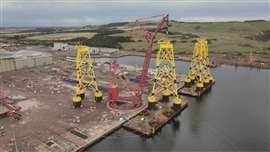How does the crane business fit into the wider equipment rental world?
18 October 2024
Equipment rental is a broad church, covering multiple sectors and industries, including construction equipment, power, events, aerial work platforms…and cranes. But what is the place of crane rental in the wider rental market?
 Heavy lift giant Mammoet used a PTC 210 DS ring crane at the Port of Nigg in Scotland for the Seagreen offshore wind farm. (Photo: Mammoet)
Heavy lift giant Mammoet used a PTC 210 DS ring crane at the Port of Nigg in Scotland for the Seagreen offshore wind farm. (Photo: Mammoet)
One way of looking at it is purely on the financial side: what proportion of equipment rental revenues are generated by crane rental companies?
There isn’t a straightforward way of measuring that, in part because of the difficulty of defining which crane-related revenues are pure rental and which are more akin to contracting work. (Not every crane company has taken Mammoet’s recent decision to create neat internal divisions for ‘rental’ and ‘project-based work.)
However, we can get a ‘big picture’ assessment of this using the IRN100 list of the largest 100 equipment rental businesses in the world, compiled by our sister publication, International Rental News (IRN).
The IRN100 listing is similar to International Cranes and Specialized Transport’s own IC100 toplist – and the equivalent list created by American Cranes & Transport (ACT) - but is based on rental-related revenues, which IRN defines as rental revenues plus sales of used fleet and other new equipment sales where these are not large-scale ‘distributor’ type sales.
This year’s IRN100, published in the June issue of IRN, reveals that 12 crane companies qualified for the list: the largest three being Maxim, Sarens and Mammoet, and the smallest being Sims Crane in the US and South Korean tower crane specialist Shinwoo.
These 12 companies generated rental-related revenues of around €5 billion in 2023, which represents just 6.5 % of the total €75 billion reported by the top 100. Seven of the 12 are in the top 50 of the IRN100, and two of them – Uperio and Shinwoo – are tower crane specialists.
Of the 12, the largest – in pure rental terms – is Maxim, ranked at number 17 on the list with revenues of under €900 million. It is closely followed by Sarens and Mammoet. (To download the full IRN100, click here.
So that’s our tentative answer – crane rental represents somewhere between 5 % and 10 % of the global equipment rental market.
A ‘modest’ share?
If that seems a modest share, crane industry folk may say, well, general equipment rental companies have extremely diverse fleets, including ‘core’ construction products such as excavators.
That is true, but there are still quite a few rental specialists that are bigger than our crane companies, including Aggreko (power), WillScot (portable accommodation and storage), Modulaire (portable accommodation) and Horizon Construction (aerial platforms).
Of course, the big difference is the sheer scale of the rental ‘generalists’. United Rentals and Sunbelt Rentals (which is owned by Ashtead Group) are both €10+ billion businesses with 1500 locations or more. The next tier down are companies like Herc Rentals (€3 billion), Loxam (€2.5 billion), and the four major Japanese rental companies (Aktio, Nishio Rental-All, Kanamoto and Nikken), which are all €800+ million concerns.
On an operational level there is a pretty distinct separation between cranes and other rental products. The vast majority of the generalist rental companies do not include significant numbers of cranes in their fleets. Most will feature telehandlers as well as yard cranes and perhaps some specialist ‘Spider’ type cranes, but they tend to shy away from the classic mobile or crawler cranes which are the bread and butter of most crane rental players.
Some crane companies dip their toes into general equipment, aerial platforms (All Family of Companies) or power (Al Faris in UAE), but it is not usually the core business. Some have made the transition away from cranes towards general rentals, with H&E Equipment Services in the US being the best example.
In fact, one key recent trend in equipment rental is for generalists to acquire the specialists. Of the top 100 rental companies, 29 can be classified as specialists, but the number is falling every year. In that respect, cranes – along with power and temporary accommodation – is one of the sectors that keeps a firm hold on its ‘separation’ and product expertise.
A target for generalists?
Which begs the question: will crane renters ever become a target for the big generalist rental companies?
You might think so, given that a key recent strategy for the generalist renters is to grow their ‘specialty’ divisions: that is happening all over the world, but most aggressively in the US, where both United Rentals and Sunbelt Rentals have invested heavily in organic and acquisition growth in areas such as cleaning equipment, pumps, trenching and temporary trackways.
In United’s case, that has meant compound average growth rate (CAGR) of 24.2 % in specialty over the past 10 years, and that business now operates through 651 locations and generates more than $4 billion in revenues each year.
These specialty businesses tend to produce higher returns than generalist equipment (the rental company can supply its ‘expertise’ along with the equipment); they are usually a good ‘fit’ in terms of integration with depots, workshops and transport; and they can help diversify the customer base away from construction.
But crane rental does not integrate so easily. They may help, to some extent, with the diversification goal, but it is very difficult to add cranes to a standard equipment rental depot, and – needless to say - you can’t deliver a crawler crane on a low loader packed with generators and lighting towers. The need to supply crane operators also marks crane rental out as different.
So, there are good reasons that crane rental businesses are usually separate – and crane professionals could doubtless think of many more. That doesn’t mean that a generalist renter could never make the leap into cranes. United Rentals and Sunbelt Rentals both operate utility truck rental divisions in the US which include digger derricks and other equipment which is closely related to cranes.
More to the point, the bigger generalists are constantly looking for growth opportunities. The US giants are investigating Europe – United and Sunbelt both have operations there – but the returns on investment remain higher in the US. Could it be that they might consider the crane business in the US to be at least as good a bet as general rentals in Europe?
MAGAZINE
NEWSLETTER
The gold standard in market research
Off-Highway Research offers a library of more than 200 regularly updated reports, providing forensic detail on key aspects of the construction equipment industry.
Our detailed insights and expert analyses are used by over 500 of the world’s largest and most successful suppliers, manufacturers and distributers, to inform their strategic plans and deliver profitable growth.








